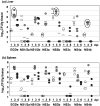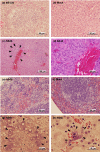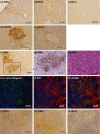Listeria monocytogenes serotype 4b strains replicate in monocytes/macrophages more than the other serotypes
- PMID: 28420823
- PMCID: PMC5487799
- DOI: 10.1292/jvms.16-0575
Listeria monocytogenes serotype 4b strains replicate in monocytes/macrophages more than the other serotypes
Abstract
We analyzed the pathogenicity of various serotypes of Listeria monocytogenes using a Balb/c mouse intravenous injection model. The survival rates of mice inoculated with strains NS1/2b (serotype 1/2b), NS3b (serotype 3b) and NS 4b (serotype 4b) were 60, 63.6 and 63.6%, respectively. Although the survival rates were similar, the bacterial growth in the liver of NS3b-infected mice was 144.5-fold higher than that in the liver of NS4b-infected mice. Histopathological analyses suggest that the NS4b strain replicated more in monocytes/macrophages, whereas the NS3b strain replicated more in hepatocytes. These results raise a possibility that the serotype 4b strains replicated more in monocytes/macrophages compared to the other serotype strains. To assess this, we isolated CD11b-positive cells from mouse livers infected with EGDe (serotype 1/2a), NS1/2b, NS3b, NS4b and the serotype 4b strains 51414 and F17 and counted the number of live bacteria in these cells. CD11b-positive cells from the NS4b-, 51414- and F17-infected mice possessed 24.4- to 42.7-fold higher numbers of live bacteria than those from mice infected with EGDe and NS3b strains. These results suggest that serotype 4b strains replicated more in monocytes/macrophages than the other serotypes, and this may be involved in the pathogenicity of serotype 4b strains, particularly in the dissemination of L. monocytogenes through the host body.
Keywords: Listeria monocytogenes; monocyte/macrophage; pathogenicity; serotype.
Figures





Similar articles
-
Course of infection and development of immunity in experimental infection of mice with Listeria serotypes.Infect Immun. 1983 Jun;40(3):1170-7. doi: 10.1128/iai.40.3.1170-1177.1983. Infect Immun. 1983. PMID: 6406363 Free PMC article.
-
Horizontal Gene Transfer and Loss of Serotype-Specific Genes in Listeria monocytogenes Can Lead to Incorrect Serotype Designations with a Commonly-Employed Molecular Serotyping Scheme.Microbiol Spectr. 2023 Feb 14;11(1):e0274522. doi: 10.1128/spectrum.02745-22. Epub 2022 Dec 6. Microbiol Spectr. 2023. PMID: 36472431 Free PMC article.
-
Salt stress-induced invasiveness of major Listeria monocytogenes serotypes.Lett Appl Microbiol. 2013 Mar;56(3):216-21. doi: 10.1111/lam.12036. Epub 2013 Jan 7. Lett Appl Microbiol. 2013. PMID: 23294476
-
Identification and characterization of nucleotide sequence differences in three virulence-associated genes of listeria monocytogenes strains representing clinically important serotypes.Curr Microbiol. 1998 May;36(5):309-18. doi: 10.1007/s002849900315. Curr Microbiol. 1998. PMID: 9541569
-
Ability of the Listeria monocytogenes strain Scott A to cause systemic infection in mice infected by the intragastric route.Appl Environ Microbiol. 2002 Jun;68(6):2893-900. doi: 10.1128/AEM.68.6.2893-2900.2002. Appl Environ Microbiol. 2002. PMID: 12039747 Free PMC article.
Cited by
-
Current methodologies available to evaluate the virulence potential among Listeria monocytogenes clonal complexes.Front Microbiol. 2024 Oct 10;15:1425437. doi: 10.3389/fmicb.2024.1425437. eCollection 2024. Front Microbiol. 2024. PMID: 39493856 Free PMC article. Review.
-
The Production of Listeriolysin O and Subsequent Intracellular Infections by Listeria monocytogenes Are Regulated by Exogenous Short Chain Fatty Acid Mixtures.Toxins (Basel). 2020 Mar 30;12(4):218. doi: 10.3390/toxins12040218. Toxins (Basel). 2020. PMID: 32235519 Free PMC article.
-
Characterization of a Novel Group of Listeria Phages That Target Serotype 4b Listeria monocytogenes.Viruses. 2021 Apr 14;13(4):671. doi: 10.3390/v13040671. Viruses. 2021. PMID: 33919793 Free PMC article.
-
Design and 3D printing of an electrochemical sensor for Listeria monocytogenes detection based on loop mediated isothermal amplification.Heliyon. 2022 Dec 26;9(1):e12637. doi: 10.1016/j.heliyon.2022.e12637. eCollection 2023 Jan. Heliyon. 2022. PMID: 36691544 Free PMC article.
-
Chlamydia Spreading from the Genital Tract to the Gastrointestinal Tract - A Two-Hit Hypothesis.Trends Microbiol. 2018 Jul;26(7):611-623. doi: 10.1016/j.tim.2017.12.002. Epub 2017 Dec 27. Trends Microbiol. 2018. PMID: 29289422 Free PMC article. Review.
References
-
- Bueno V. F., Banerjee P., Banada P. P., José de Mesquita A., Lemes-Marques E. G., Bhunia A. K.2010. Characterization of Listeria monocytogenes isolates of food and human origins from Brazil using molecular typing procedures and in vitro cell culture assays. Int. J. Environ. Health Res. 20: 43–59. doi: 10.1080/09603120903281283 - DOI - PubMed
-
- Chambel L., Sol M., Fernandes I., Barbosa M., Zilhão I., Barata B., Jordan S., Perni S., Shama G., Adrião A., Faleiro L., Requena T., Peláez C., Andrew P. W., Tenreiro R.2007. Occurrence and persistence of Listeria spp. in the environment of ewe and cow’s milk cheese dairies in Portugal unveiled by an integrated analysis of identification, typing and spatial-temporal mapping along production cycle. Int. J. Food Microbiol. 116: 52–63. doi: 10.1016/j.ijfoodmicro.2006.12.035 - DOI - PubMed
MeSH terms
LinkOut - more resources
Full Text Sources
Other Literature Sources
Medical
Research Materials
Miscellaneous

